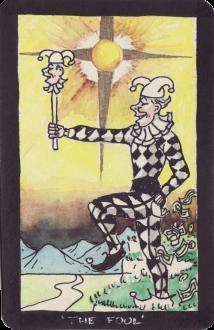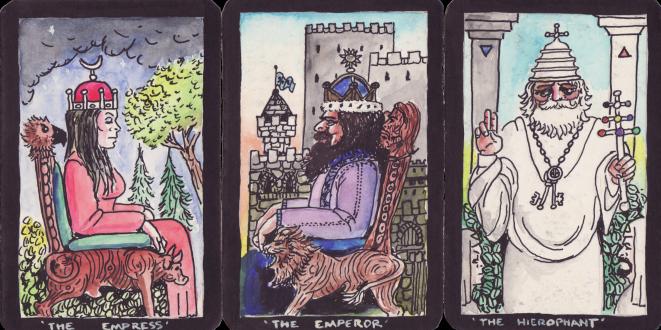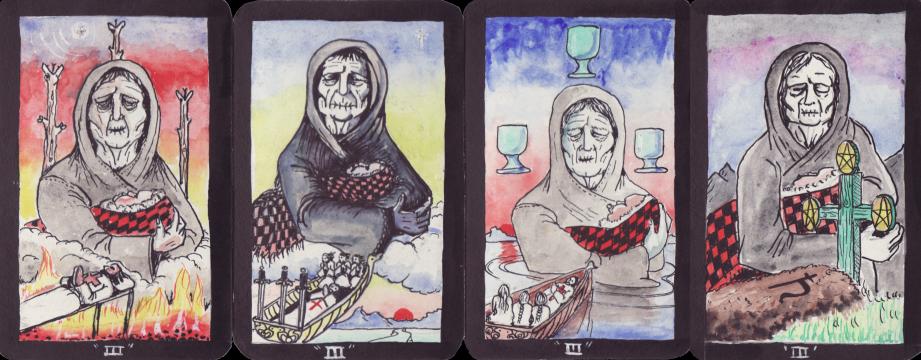 The Tarot of Robert Ellaby
The Tarot of Robert Ellaby Robert Ellaby is a British surrealist artist much influenced by esotericism and kabbalah. I am pleased to own one of his paintings which I commissioned from him on the theme of the Splendor Solis. I also have scans of one of his series of artworks the Cosmic Christ which I placed on my website.
In the 1980s Bob worked on designs for a complete tarot deck. For him this was an exercise in creating a unique series of images that reflected a kabbalistic structure to the sequence of tarot images. I do not think he ever thought of having the deck published.
This is a full 78 card deck and each of the pip cards is emblematic. In this deck the pip card system is particularly important as it reflects a kabbalistic structure. Unlike many kabbalistic decks which resort to numbers, Hebrew letters and various abstract esoteric correspondences, here Bob Ellaby has absorbed all this material and recreated the essence in a emblematic form. The artwork is created with pen drawings which are coloured with thin washes of water based pigments.
The Major Arcana.
For the most part Ellaby has, in his Major arcana, held close to the conventional images, though realised in his own style, and incorporating little flourishes and details. He does not use decorations but each symbol depicted is a considered part of the image. Note, for example, the arms and backrests on the thrones of the Empress and Emperor, their crowns and the fact that they face in opposite directions.

Other cards in his Majors explore a less convention depiction of the established imagery. The Moon card has the classical image of Daphne transformed into a tree and here the leaves show a growth and ripening process through their colour changes. We note the black cat and white dog and the three phases of the Moon. Strength uses the image of Samson in the Temple, while the World incorporates an hermaphroditic figure

The Minor Arcana.
In many decks the Minor arcana fail to engage. Often they are not emblematised or merely repeat the imagery used by Pamela Coleman Smith for the Waite deck. Some artists stride out on their own path and create new individual images for the pip cards, but often these do not cohere or present a unified narrative. Ellaby here creates a coherent set of images through the four suits, which he derives from his deep study of the kabbalah.
It is perhaps only when one lays these out in rows that the structure can best be seen.

To Ellaby, the ten pips are associated with the ten sephiroth, from one (Kether) to 10 (Malkuth). He has chosen a motif for each sephirah and then explores these through the four elements or worlds that constitute the suits. These is so much symbolic detail compressed into these images that I cannot analyse them all here, but I will merely take two examples. First let us look at the "Threes".

The third Sephirah is Binah, sometimes seen as 'Understanding'. Binah is thought of as feminine, and here Ellaby uses an image of the wise old woman, the crone. On the lower left the soul is seen being transported and transformed through fire, air water and earth in the four suits.

The ninth Sephirah is Yesod, often called 'the Foundation'. Ellaby pictured this using an image he often returns to in his paintings, that of the open living skull. From this open brain pan, fire emerges in the suit of wands, in swords the skull is cleaved open and air emerges. In the Nine of Cups, the open skull is a well from which streams of water flow forth, and in the suit of the Earth element, Pentacles, the nine shows a tree growing out of the skull.
The tarot of Robert Ellaby is a coherent exploration of the conceptions behind the 78 cards, seen through the kabbalah and his own surrealist creativity.

 Facebook page
Facebook page